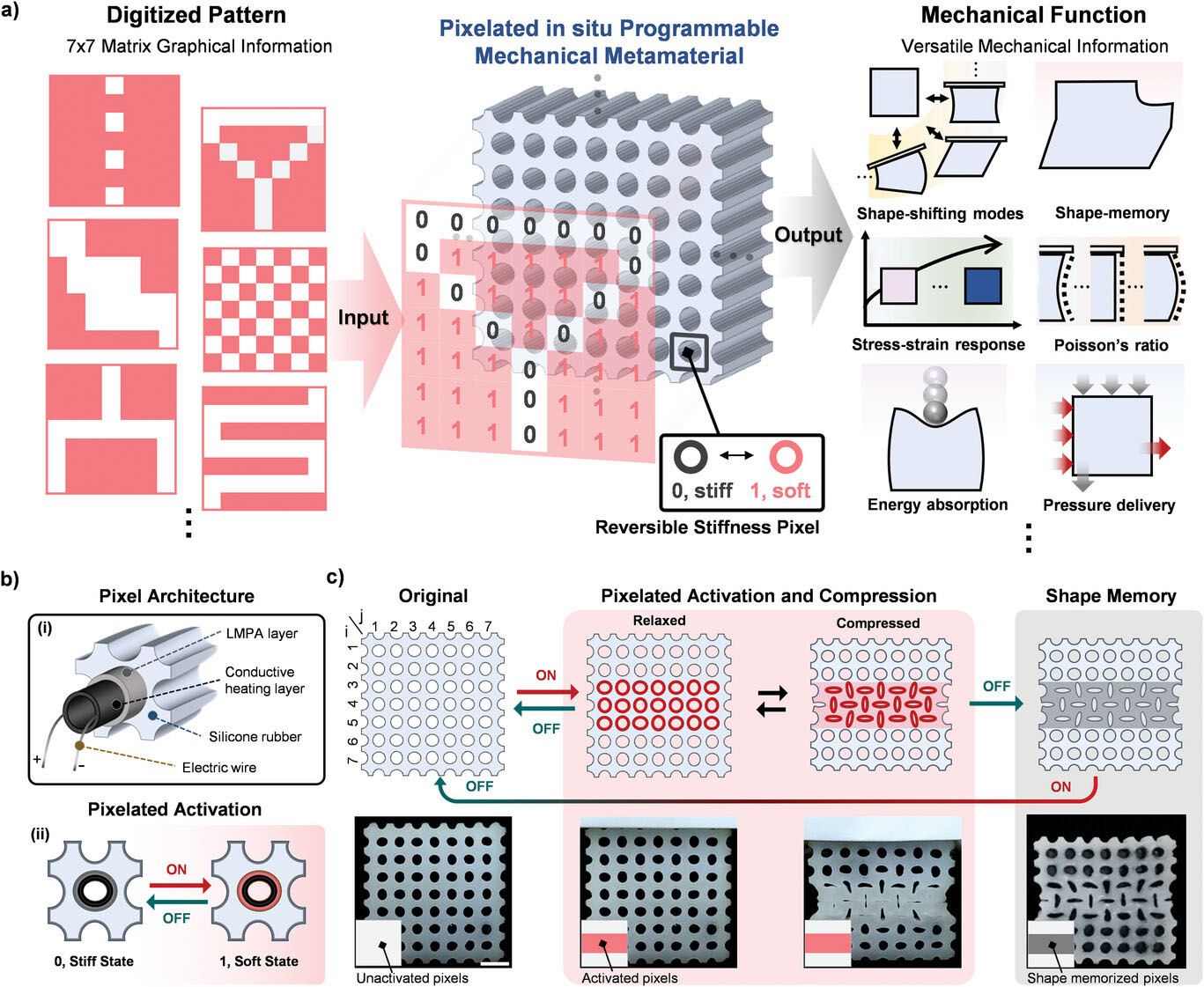| Dec 07, 2023 | |
Graphical encoding of stiffness patterns in metamaterials enables reprogrammable and adaptive soft machines |
|
| (Nanowerk News) In the quest to develop robots and interactive machines that are safe, adaptable, and intelligent like organisms in nature, researchers have increasingly focused attention on soft and deformable systems constructed using elastic polymers and gels rather than hard material. | |
| These "soft machines" are constructed from compliant, deformable materials that match the properties of biological tissues. This allows more natural motion and interaction compared to rigid robots. Potential applications include: rescue robots that can squeeze through tight spaces; soft grippers that can handle fragile objects; comfortable and biocompatible assistive wearables; and artificial skin with touch sensing capabilities for more organic human-computer interaction. | |
| However, despite their promise, current soft machines lack the versatile real-time reconfigurability and environment-driven adaptability exhibited by soft-bodied creatures like octopuses that can actively tune the shape, density, and color of their morphable bodies to match dynamic situations. This enduring challenge has slowed the full realization of soft machines’ potential across areas from reversible device fabrication techniques to camouflage systems. | |
| Now though, researchers from South Korea’s Ulsan National Institute of Science and Technology have developed an encodable “digital mechanical metamaterial” that allows the mechanical properties and behaviors of a material to be reconfigured through encoded patterns, bringing us closer to truly adaptive soft robotics. | |
| They publihes their findings in ("Digital Mechanical Metamaterial: Encoding Mechanical Information with Graphical Stiffness Pattern for Adaptive Soft Machines"). | |
 |
|
| Concept and mechanism of pixelated in situ programmable mechanical metamaterial (PPMM) for in situ programming of mechanical behaviors. a) The design concept of using digital patterns of binary numbers “0” and “1” to project versatile mechanical information. The binary information of a digital pixel is translated to discrete stiffness states of the corresponding mechanical pixel. A schematic gallery of several mechanical capabilities is shown derived from various digitalized pattern instructions. b,i) Mechanical pixel architecture and ii) reversible stiffness mechanism using phase transition of the LMPA layer. c) Operating processes for developing reprogrammable mechanical functionalities and exemplary shape reconfiguration and shape memory effect of the PPMM. (Reprinted with permission from Wiley-VCH) | |
| This research builds on recent advances in mechanical metamaterials – engineered materials that gain unusual global properties from specific local structural patterns. Various mechanical metamaterials have already shown promise for programmable shapeshifting, tunable Poisson's ratios, and energy absorption. | |
| However, once fabricated, these metamaterials are usually limited to the mechanical capabilities predefined during design. Progress has been made by integrating “smart” stimuli-responsive materials that can alter configurations in response to external triggers. But the number of achievable states still constrains versatility. | |
| The new digital mechanical metamaterial aims to overcome these limitations using an elegantly simple concept - encoding mechanical information into graphical stiffness patterns, much like how digital information is encoded through binary numbers. The material consists of a porous composite structure with an elastomeric frame and elliptical voids. Inside each void is a “mechanical pixel” containing a low-melting-point alloy (LMPA) layer paired with a conductive heating element. By running current through select heating elements, the phase of corresponding LMPA pixels can be toggled between liquid and solid states, translating to dramatic switches between soft and rigid mechanical behaviors. | |
| Using this digitization approach, the researchers demonstrate how spatial and temporal variations in 7x7 pixel activation patterns allow gradual tuning of numerous mechanical capabilities within a single reprogrammable material system, encompassing over 249 possible configurations. | |
| For instance, encoding diagonal patterns produces shear deformation under compression, while asymmetric vertical patterns generate bending, all tunable by slope and gradient. Local stiffness adjustments also enable customization of global properties like Poisson's ratio across a wide range from auxetic to positive. Shape-memory effects allow temporary or lasting shape reconfiguration triggered by pattern and load sequencing. | |
| Remarkably, blending extreme base patterns that generate negative and positive Poisson's ratios respectively yielded intermediate values and even novel properties exceeding both base states. This highlights how digitally accessing localized constituent behaviors that are conventionally considered detrimental allows emergence of unexpected global functionalities inaccessible through conventional means. | |
| To demonstrate adaptability, the metamaterial is successfully reconfigured in situ to act as an impact energy absorber or pressure transmitter. By adjusting pixel patterns, the optimal absorption capability is achieved for light or heavy impacts. For pressure transmission, paths are programmed to route applied loads towards specific locations. | |
| The unique blend of instability-driven elasticity, phase-change pixels with extreme property contrast, precise spatial-temporal stiffness programming, and machine learning optimization creates a versatile material system with exceptional reconfigurability. The pixelated encoding paradigm establishes an expansive mechanical design space while maintaining coherent structure-property relationships that ensure predictable outcomes. This research provides a promising platform for developing the next generation of intelligent, adaptable soft machines. | |
| Further work should focus on incorporating sensing and logic for autonomous environment perception and response. With continued advancement, digitally programmable metamaterials may soon match biological systems in cognitive ability. Such artificial yet adaptive materials could revolutionize applications from soft robotics to biomedicine and human-computer interfaces. |
| Source: Nanowerk (Note: Content may be edited for style and length) |
We curated a list with the (what we think) 10 best robotics and AI podcasts – check them out!
Also check out our Smartworlder section with articles on smart tech, AI and more.

